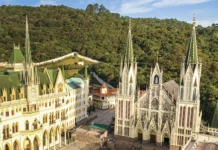Those who fight clad in the golden armour of faith and armed with the practice of virtue will win the hero’s reward after the battle.
The Monastery of Saint Mary of the Victory, landmark of fifteenth-century Portuguese Gothic architecture, dates back to a promise made to the Blessed Virgin by John I, King of Portugal, and his Constable, St. Nuno Álvares Pereira. In August of 1385, they were engaged in battle to affirm the independence of the Portuguese kingdom before Castile and León and, despite the fact that their warriors were vastly outnumbered by the powerful rival cavalry, the conflict ended in a brilliant victory.

One of the most beautiful, famous and symbolic edifices in Portuguese history was built to honour a vow they made to Our Lady on that occasion. Today it is widely known as Batalha Monastery—literally the Monastery of the Battle—in allusion to the celebrated episode.
Viewed from the exterior, the structure seems to epitomize, in its massive and solidly built walls, the combativeness of a generation of fearless and faith-filled warriors, hardened by a thousand heroic struggles. The austerity of its lines is enhanced by its soaring dimensions and the golden hue of its time-worn stones. The main façade reveals a distinct military spirit that appears to reflect the characteristics of a knight: composure, determination, and combativity…
The main portal, however, is less austere and flanked by solid buttresses of monumental height, which express their own contingency, while drawing gazes and spirits upward. The fine filigree stonework of its arches and columns welcomes the visitor into the belligerent edifice, where cloisters and gardens reveal its contemplative heart, inhabited for centuries by Dominican religious.
Thus, in Batalha Monastery, we find embers of arduous warfare together with the aroma of pious contemplation—solidity that harmonizes indestructibility with the delicacy of ornamentation. This merging of complementary opposites in perfect unity invites us, men and women of the twenty-first century, to confront our daily struggles, confiding in the aid of grace.

In this way, the history of the monastery evokes confidence in the infallible aid of the Mother of Divine Grace, who will bring us victory. Those who fight clad in the golden armour of faith and armed with the practice of virtue will win the hero’s reward after the battle: the palm of triumph, eternal glory, the kingdom of the blessed. To these it could be said: “‘For yet a little while, and the coming one shall come and shall not tarry; by My righteous one shall live by faith, and if he shrinks back, my soul has no pleasure in him.’ But we are not of those who shrink back and are destroyed, but of those who have faith and keep their souls” (Heb 10:37-39). ◊







